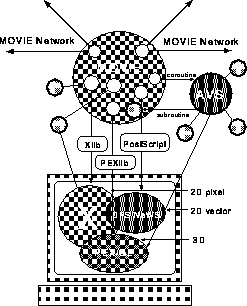




Next: 17.2.8 ``In Large'' Extensibility
Up: 17.2.7 Integrated Visualization Model
Previous: 3D MOVIE
The integrated graphics model in MovieScript is simple at the user level
and complex at the implementation level, as illustrated in
Figure 17.7.

Figure 17.7: Integrated Graphics Model in MovieScript. Uniform interface in
terms of primitive types is constructed to X, DPS/NeWS, and PEX/GL
components of the Open Systems software and implemented,
correspondingly, in terms of the Xlib, GL/PEXlib and PostScript
communication protocols. Additionally, an interface to the AVS server
is constructed, supporting both the subroutine and coroutine operation
modes. The AVS-style extensibility model in terms of the UNIX dataflow
processes is illustrated both for AVS and MOVIE servers. Within this
model, one can also import other graphics models and applications to
the MOVIE environment. This is illustrated on the example of the
third-party X Window application which is configured as a MovieScript
object or operator.
Our main goal is to bring the heterogeneous collection of present
standard subsystems (X, Motif/OpenLook, DPS/NeWS, PHIGS/PEX/GL) to the
uniform sector of a high-level language. Interfaces to individual
subsystems were discussed above. The overall strategy is to build
first a uniform set of low-level primitive types for GUI toolkits and
three-dimensional servers, structured as smooth extensions of the
DPS/NeWS server-based Postscript graphics model for the two-dimensional
vector graphics. This interpreted layer is then used in the next stage
to design the high-level object-oriented graphics world in terms of
more complex derived types. The resulting graphics support is very
powerful and unique in some sense: It utilizes fully the available
Open Systems graphics software resources; it conforms to one of the
standards (PostScript) at the level of primitives; and finally, it
provides the user-friendly, intuitive, and complete programming
interface for modern graphics applications.
As an independent component, we provide also the MovieScript interface
to dataflow packages such as AVS/Explorer. Both coroutine and
subroutine models for MOVIE-based AVS modules are supported, which
allows for diverse interaction patterns between MOVIE and AVS servers.
The AVS interface is redundant since the graphics functionality of
systems such as AVS/Explorer will soon be included in the PEX/GL-based
3D MOVIE model, but it is useful in the current stage where various
components of the 3D MOVIE model are still in the implementation
process. In particular, the AVS interface was used in the Map
Separates application, providing high-quality
three-dimensional display tools for the MovieScript field algebra-based
imaging and histogramming. We discuss this application in
Chapter 3.





Next: 17.2.8 ``In Large'' Extensibility
Up: 17.2.7 Integrated Visualization Model
Previous: 3D MOVIE
Guy Robinson
Wed Mar 1 10:19:35 EST 1995





